Creating and Managing Curtains for Version 7.0
Contents
Overview
1) Strategically using Curtains in the chart is a way to highlight periods of time that have special meaning to your audience such as periods with critical schedule constraints, vacation periods, or project reviews.
2) Curtains can be inserted and edited in the chart in several ways:
- a) You can use the OnePager ribbon's Insert tab and the Curtains button in the Annotations section to access the Curtain Properties form.
- b) Additionally, OnePager Pro and Express provides enhanced curtain creation and management capabilities in the chart where you can define and edit Curtains using controls associated with Time Axis Levels and Cells.
- c) Finally, you can add a Curtain to the chart from an already existing Curtain using the existing Curtain's context menu Add another ... command.
3) This article specifically describes the controls for creating, editing, copying (adding another), and deleting Curtains in the chart using the OnePager ribbon's Insert tab's Curtains button as the starting point.
4) References to the specific articles describing the capabilities and features for Curtain graphics associated with the Time Axis Levels and Cells feature are provided in the table below:
About Curtains
1) A Curtain is a vertical strip, usually in a highlighted color, that identifies a period of time across all rows.
2) The example below shows a Curtain entitled Critical Resource Period that appears from 4/1/2019 to: 9/30/2019.
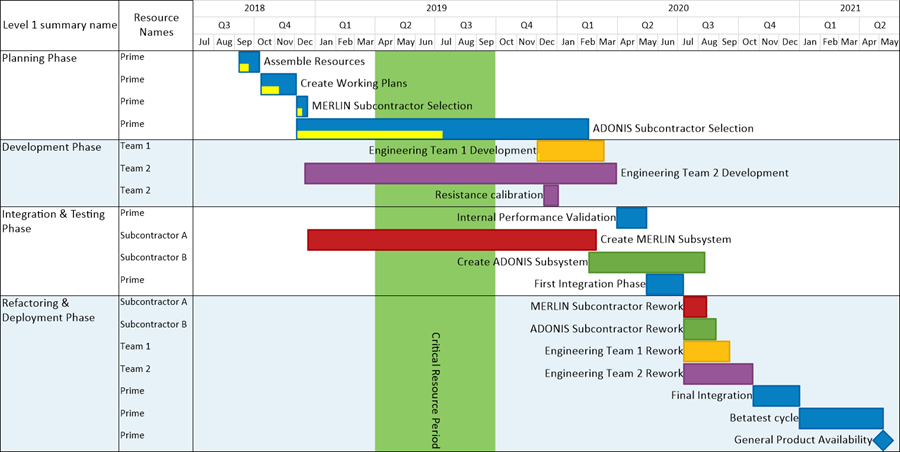
3) Curtains can be added to the chart, edited, copied, and deleted as necessary.
4) A Curtain context menu is provided for editing individual Curtains in the chart and for managing the appearance of Curtains in some or all snapshots.
Adding a Curtain
1) To add a new Curtain to a chart, start at the OnePager ribbon's Insert tab.
2) On the OnePager ribbon's Insert tab click the Curtain button as shown below:
3) This accesses Curtain Properties form that allows you define the Start and End dates, appearance, and text label for the Curtain:
4) Once you entered the Start and End dates and other properties selections, click the OK button to add the Curtain.
5) In charts with multiple snapshots, this method of adding a Curtain puts the Curtain in all snapshots.
Editing a Curtain
1) Editing a Curtain is similar to editing all the other shapes appearing in the chart such as Comment boxes.
2) First, right-click on the Curtain to access the Curtain's context menu shown below:
3) Click the Properties ... command in the Context menu to access the Curtain Properties form shown here:
4) Make your option selections for font text properties and rotation, Curtain text horizontal and vertical alignment. fill color, Curtain border line properties, and transparency level.
5) The controls in the Curtain Properties form are identical to the controls in the Shape Properties form associated with the Free box.
6) The exceptions are that the Shape Properties form does not contain a Transparency slider bar and the Maintain aspect ratio checkbox in the Shape Properties form is replaced with the Rotate text 90 degrees checkbox in the Curtain Properties form.
- a) For more information on the Free box's Shape Properties form, please see this link: Changing the Properties of a Free Box. 14.0.1-61
- b) The No Fill feature found on the Font properties form accessed from the Fill color dropdown button on the Curtain Properties form applies to a Curtain's Fill Color. See the referenced sections for more information on the No Fill option: Creating and Managing Comment Boxes - Background Color Management 13.0.1-61.
7) In charts with multiple snapshots, this method of editing a Curtain changes the Curtain’s properties in all snapshots where the Curtain appears.
8) Once you have completed your Curtain editing actions, click the OK button on the Curtain Properties form.
Deleting Curtains
1) Deleting Curtains is similar to deleting any other shape in the chart such as a Comment box.
2) First, right-click in the Curtain area to access the Curtain's context menu and the Delete command from the context menu below:
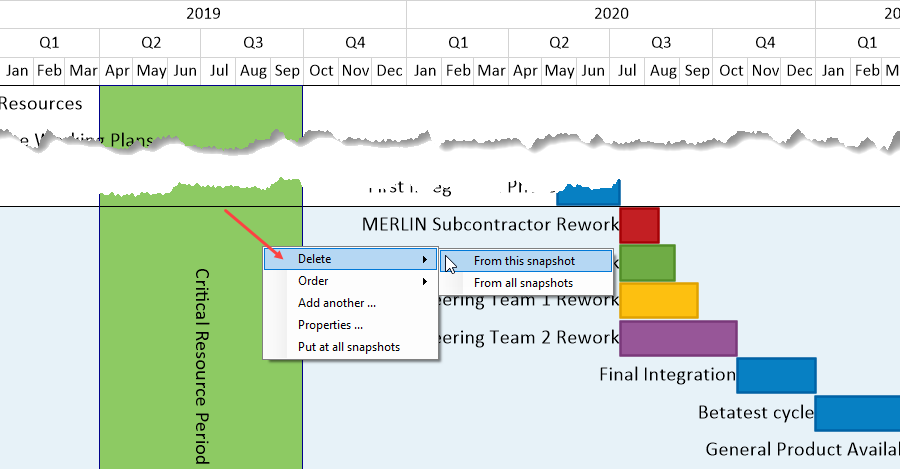
3) Using the sub-command Delete: From this snapshot deletes the Curtain from the current displayed snapshot. Curtains that remain in other snapshots are treated as a single entity with respect to their properties.
4) The sub-command Delete: From all snapshots deletes all Curtains from all snapshots.
Ordering Curtains
1) Curtains can be ordered in the chart from front to back in the same way that Free boxes can be ordered in the chart using the same context menu commands.
2) For specifics on ordering Free boxes in the chart, please see the section at this link: Ordering Free Boxes. 14.0.1-61
3) When the Order's sub-commands are used, the results with respect to the Z-Level positioning of the Curtain is shown in all snapshots where the Curtain is showing.
Adding Another Curtain
1) Also shown in the context menu above is the Add another… sub-command which is a convenient way to place another Curtain into the chart with different properties.
2) First, right click on the Curtain showing in the chart to access the Curtain's context menu, then click the Add another… sub-command to access the Curtain Properties form and use the form to set the properties of the new added Curtain as shown below:
3) Click the OK button when finished and the updated chart looks like this:
4) As with all uses of the Curtain Properties form, when you click the OK button the additional Curtain is shown in all snapshots.
Putting A Curtain in Some Snapshots
1) When the Curtain Properties form is used to add a Curtain in the chart, the Curtain is put in all snapshots.
Procedure for Displaying Curtains in Some Snapshots
2) There is no Attach to all snapshots checkbox in the Curtain Properties form as there is in the Create or edit comment box form.
3) The recommend way to display a Curtain in one or a select set of snapshots is to use this two step procedure:
- a) First create the Curtain with its desired properties which makes the Curtain appear in all snapshots as the default result.
- b) Then, use the context menu's Delete command to individually delete the undesired Curtains from snapshots where the Curtain should not be showing.
Reinstating Curtains in the Future
4) Subsequent project demands can require that you later need to put the Curtain back in all snapshots.
5) To do this, just follow the steps below:
- a) To put a Curtain in all snapshots, use the Put at all snapshots command found in the right-click context menu for the existing Curtains in the snapshot where it is showing as done below:
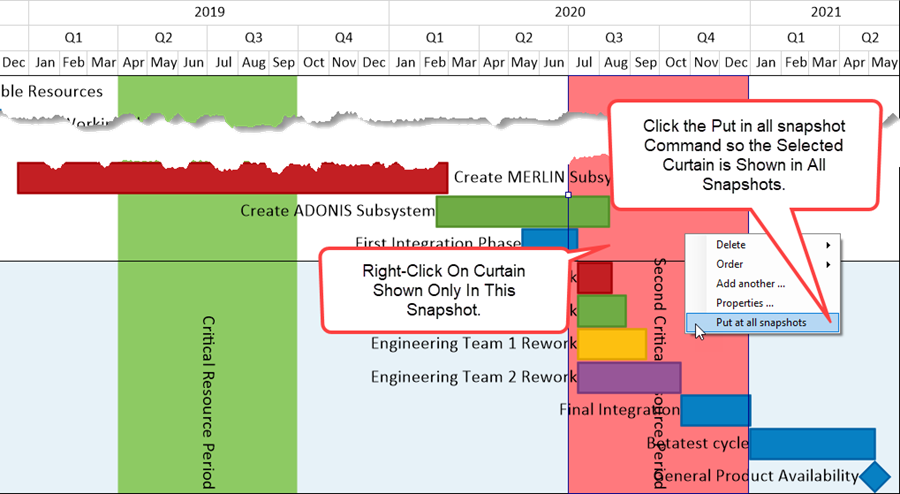
- b) After clicking the Put at all snapshots command, the selected Curtain is shown in all snapshots.
6) By using the first procedure above, you can now selectively delete Curtains from snapshots where the selected Curtains are not desired.
Keeping Track of Curtains in the Chart
1) In any chart where Curtains are used for multiple purposes, it may become necessary to consult a list of Curtain entities that are in the chart or snapshots.
2) The Time Axis Levels and Cells feature of OnePager provides a location where all Curtains in the chart are listed.
3) Whenever OnePager adds a Curtain to the chart, regardless of the method used, an entry is made in the Curtain's and Timespans Grid found in the Chart Properties form's Time Axis tab's Format sub-tab as shown below for the example used in this article thus far:
4) For more information on The Grid, the Chart Properties form's Time Axis tab, and other Curtain features related to the Time Axis Levels and Cells feature, please see the table of links in the Overview section at: Creating and Managing Curtains-Overview 16.0.1-70
5) For more general information on the Time Axis Levels and Cells feature in OnePager, please reference this series of articles: Modifying the Time Axis (Portal) 22.0.1-70
Resizing a Curtain
1) As described above, the width of a curtain in terms of its Start and End Dates can be edited through the Curtain Properties form.
2) The width of the Curtain can also be manually edited in the chart.
3) To do this follow the steps described below:
- a) Select the Curtain by left-clicking within the Curtain area.
- b) This selects the Curtain and shows a left and right grab box on the left and right border of the selected Curtain.
- c) Changes to the Start and End Dates for selected Curtain can be done by using these Curtain grab boxes on the left and right borders to drag these these grab boxes to the left or right as appropriate as shown below:
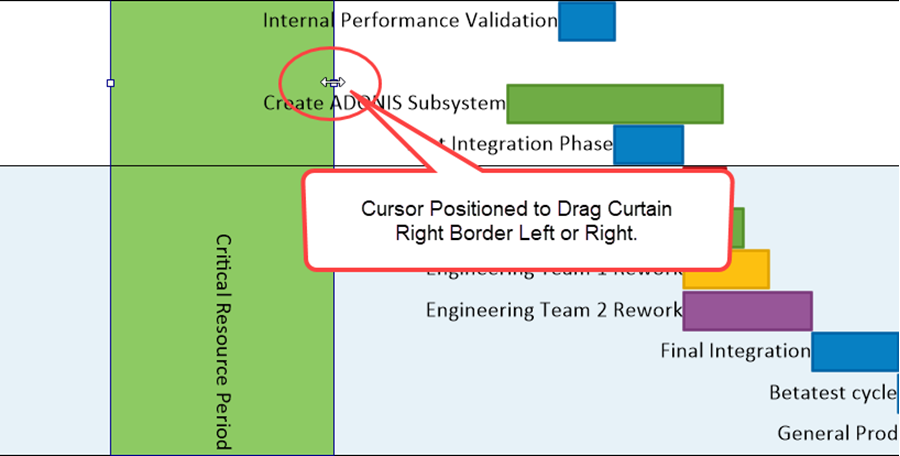
4) Dragging the mouse to the left or right moves the Curtain’s border as desired.
5) In the example above, the right border is dragged to the right to increase the width of the Curtain as shown below:
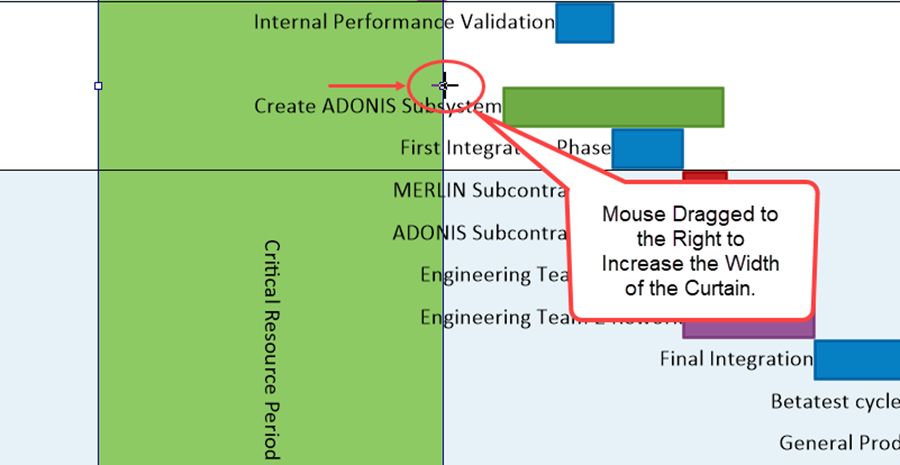
Selecting a Very Narrow Curtain in the Chart
1) You can find it difficult to select a Curtain with the mouse click when the Curtain is very narrow.
2) To select such a Curtain we recommend the following:
- a) Position the mouse at the bottom of the screen (in the footer area) to the left of the Curtain.
- b) Hold the left mouse button down and drag the mouse upward and to the right until the Lasso completely encloses the Curtain.
- c)) When you release the left mouse button, the Curtain is selected.
5) You can now widen the Curtain by dragging the grab boxes with the mouse cursor to the left or right as shown below:
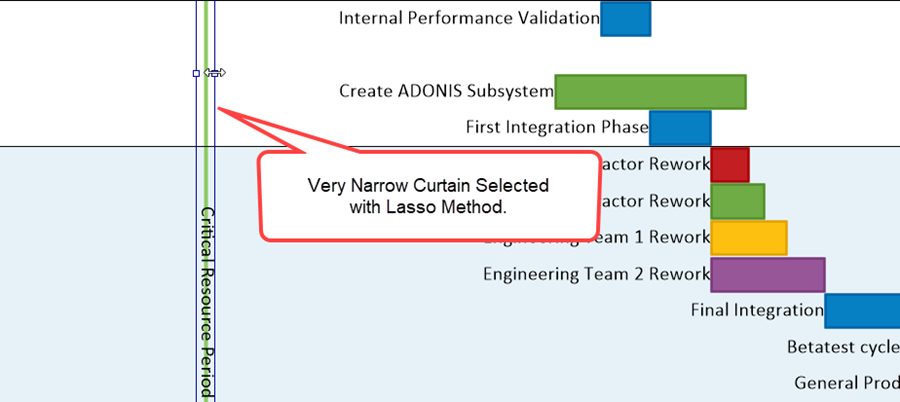
Related Links
Creating and Managing Comment Boxes 13.0.1-70
Creating and Managing Free Boxes 14.0.1-70
Creating, Editing, and Managing Time Axis Daily Curtains for OnePager Pro 22.5.5-70
Creating, Editing, and Managing Time Axis Daily Curtains for OnePager Express 22.5.6-70
Managing Inserted Curtains for OnePager Pro 22.5.7-70
Managing Inserted Curtains for OnePager Express 22.5.8-70
Managing Working Hours and Non-Working Hours for OnePager Pro 22.5.3-70
Managing Working Hours and Non-Working Hours for OnePager Express 22.5.4-70
Editing Time Axes with the Chart Properties Form for OnePager Pro 22.4.1-70
Editing Time Axes with the Chart Properties Form for OnePager Express 22.4.2-70
Manual Editing the Time Axis for OnePager Pro 22.4.3-70
Manual Editing the Time Axis for OnePager Express 22.4.4-70
(16.0.1-70)